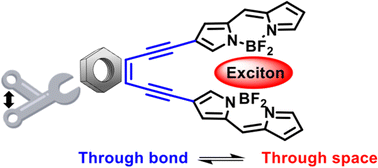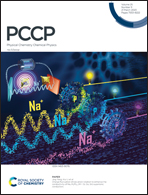Engineering giant excitonic coupling in bioinspired, covalently bridged BODIPY dyads†
Abstract
Strong excitonic coupling in photosynthetic systems is believed to enable efficient light absorption and quantitative charge separation, motivating the development of artificial multi-chromophore arrays with equally strong or even stronger excitonic coupling. However, large excitonic coupling strengths have typically been accompanied by fast non-radiative recombination, limiting the potential of the arrays for solar energy conversion as well as other applications such as fluorescent labeling. Here, we report giant excitonic coupling leading to broad optical absorption in bioinspired BODIPY dyads that have high photostability, excited-state lifetimes at the nanosecond scale, and fluorescence quantum yields of nearly 50%. Through the synthesis, spectroscopic characterization, and computational modeling of a series of dyads with different linking moieties, we show that the strongest coupling is obtained with diethynylmaleimide linkers, for which the coupling occurs through space between BODIPY units with small separations and slipped co-facial orientations. Other linkers allow for broad tuning of both the relative through-bond and through-space coupling contributions and the overall strength of interpigment coupling, with a tradeoff observed in general between the strength of the two coupling mechanisms. These findings open the door to the synthesis of molecular systems that function effectively as light-harvesting antennas and as electron donors or acceptors for solar energy conversion.



 Please wait while we load your content...
Please wait while we load your content...